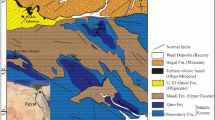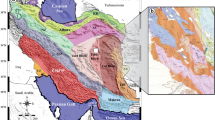Abstract
The Fort Munro Formation is 200-m-thick mixed carbonate–siliciclastic succession of Late Cretaceous (Campanian) age exposed at the Rakhi Nala Section, Sulaiman Range, Lower Indus Basin, Pakistan. The Fort Munro Formation is representing thin- to thick-bedded limestone with interbedded marls, shale and sandstone. Detailed microfacies analysis revealed the recognition of 15 microfacies types (11 carbonate and 4 sandstone). These facies were deposited on both inner and middle ramp platform. The inner ramp sediments are more widespread than the corresponding middle ramp including open-marine, skeletal shoals, semi-restricted, carbonate sand shoals and banks and lagoon depositional environments. The uppermost part of the Fort Munro Formation has received sufficient amount of siliciclasts, thereby producing a sandstone texture. These siliciclasts indicate the tectonic uplift, which thereby increases the source area rejuvenation. Therefore, a mixed carbonate–siliciclastic, moderately storm-dominated homoclinal ramp depositional environment is suggested for the Fort Munro Formation.








Similar content being viewed by others
References
Abyat A, Lari AR (2015) Paleoecology & Paleobiogeography of Orbitoides Genus in Zagros Basin (SouthWest Iran). J Earth Sci Clim Change 6(1):1
Afzal J (1996) Late Cretaceous to early Eocene Foraminiferal biostratigraphy of the Rakhi Nala Area, Sulaiman range, Pakistan. Pak J Hydrocarbon Res 8:1–24
Banks CJ, Warburton J (1986) Passive-roof duplex geometry in the frontal structures of the Kirthar and Sulaiman Mountain Belts Pakistan. J Structt Geol 8:229–237
Beck RA, Burbank DW, Sercombe WJ, Riley GW, Barndt JK, Berry JR, Afzal J, Khan AM, Jurgen H, Metje J, Cheema A, Shafique NA, Lawrence RD, Khan MA (1995) Stratigraphic evidence for an early collision between northwest India and Asia. Nature 373:55–58
Brasier MD (1975a) Ecology of recent sediment-dwelling and phytal foraminifera from the lagoons of Barbuda, West Indies. J Foraminiferal Res 5:42–46
Brasier MD (1975b) The ecology and distribution of Recent Foraminifera from the reefs and shoals around Barbuda, West Indies. J Foraminiferal Res 5:193–210
Burchette TP, Wright VP (1992) Carbonate ramp depositional systems. Sediment Geol 79:3–57
Caus E, Bernaus JM, Gomez-Garrido A (1996) Biostratigraphic utility of species of the genus Orbitoides. J Foraminiferal Res 26:124–136
Dunham RJ (1962) Classification of carbonate rocks according to depositional textures. AAPG Memoir 1:108–121
Eames FE (1952) A contribution to the study of the Eocene in Western Pakistan and in Western India: the Geology of the standard sections in the Western Punjab and in the Kohat district. Geol Soc Lond Q J 107:173–196
Fitzsimmons R, Buchanan J, Izatt C (2005) The role of outcrop geology in predicting reservoir presence in the Cretaceous and Paleocene successions of the Sulaiman Range, Pakistan. AAPG Bull 89(2):231–254
Flügel E, Munnecke A (2010) Microfacies of carbonate rocks: analysis, interpretation and application. Springer, Berlin
Geel T (2000) Recognition of stratigraphic sequences in carbonate platform & slope deposits: empirical models based on moicrofacies analysis of Palaeogene deposits in south eastern Spain. Palaeogeogr Palaeoclimatol Palaeoecol 155:211–238
Goldbeck EJ (2007) Faunal Provinces and Patterns of Diversity in Late Cretaceous (Santonian-Maastrichtian) Larger Foraminifera, Rheinische Friedrich Wilhelms Universität Bonn. In; Institutfür Paläontologie, Nussallee, vol 8, p 53115 Bonn
Gräfe KU (2005) Late Cretaceous benthic foraminifers from the Basque-Cantabrian Basin, Northern Spain. J Iberian Geol 31(2):277–298
Haynes JR (1981) Foraminifera: scientific and medical division. Macmillan Publishers Ltd, London
Hohenegger J (1996) Remarks on the distribution of Larger Foraminifera (Protozoa) from Belau (Western Carolines). Kagoshima Univ Res Center South Pacifi 30:85–90
Hottinger L (1997) Shallow benthic foraminiferal assemblages as signals for depth of their deposition and their limitations. Bull Soc Géol France 168:491–505
Hunting Survey Corporation (HSC) (1961) Reconnaissance geology of part of West Pakistan (Colombo plan cooperative project). In: Canada Govt. Toronto, pp 1–555 P
Kadri IB (1995) Petroleum geology of Pakistan. Pakistan Petroleum Limited, Karachi
Kakar MA, Ghazi S, Khan AS, Mohammed AK, Hanif T (2001) Petrology and provenance of the Upper Cretaceous Mughal Kot Formation and Pab Sandstone, Western Sulaiman Thrust and Fold Belt, Pakistan
Malkani MS (2010) Updated stratigraphy and mineral potential of Sulaiman Basin, Pakistan. Sindh Univ Res J (Sci Ser) 42 (2):39–66
Marks P (1962) Variation and Evolution in Orbitoides from the Cretaceous of the Rakhi Nala, West Pakistan. Geol Bull Punjab Univ Lahore 2:15–24
Murray JW (1991) Ecology and paleoecology of Benthic Foraminifera. Wiley, London, p 397p
Nagappa Y (1959) Foraminiferal Biostratigraphy of the Cretaceous: eocene succession in the India-Pakistan Burma region. Micropaleontology 5:145–192
Pettijohn FJ, Potter PE, Siever R (1987) Sand and sandstone, 2nd edn. Springer, NewYork
Robles-Salcedo R, Rivas G, Vicedo V, Caus E (2013) Paleoenvironmental distribution of larger foraminifera in Upper Cretaceous siliciclastic-carbonate deposits (Are´n Sandstone Formation, south pyrenees, northeastern spain). PALAIOS 28:637–648
Romero J, Caus E, Rosell J (2002) A model for the palaeoenvironmental distribution of larger foraminifera based on late middle Eocene deposits on the margi of the South Pyrenean basin (NE Spain). Palaeogeogr Palaeoclimatol Palaeoecol 179:4–56
Ruban DA, Sallam ES, Wanas HA (2019) Middle-Late Jurassic sedimentation and sea-level changes on the northeast African margin: a case study in the Khashm El-Galala area, NE Egypt. J Afr Earth Sci 156:189–202
Sallam ES, Ruban DA (2020) Facies analysis and depositional environments of the Miocene syn-rift carbonate siliciclastic rock packages in the northwest Gulf of Suez, Egypt. Carbonates Evap 35:10
Sallam ES, Wanas HA, Osman R (2015) Stratigraphy, facies analysis and sequence stratigraphy of the Eocene succession in the Shabrawet area (north Eastern Desert, Egypt): an example for a tectonically influenced inner ramp carbonate platform. Arab J Geosci 8(12):10433–10458
Sallam ES, Issawi B, Osman R, Ruban DA (2018) Deposition in a changing paleogulf: evidence from the Pliocene–Quaternary sedimentary succession of the Nile Delta, Egypt. Arab J Geosci 11:558
Scholle PA, Ulmer-Scholle DS (2003) A color guide to the petrography of carbonate rocks: grains, texture, porosity and diagenesis. In: Bulletin of the American Association of Petroleum Geologists, vol. 77, Tulsa, Oklahoma USA
Shah SMI (1977) Stratigraphy of Pakistan. Geol Surv Pak Mem 1977:12
Shah SMI (2009) Stratigraphy of Pakistan. Geol Surv Pak Mem 2009:22
Van Gorsel JT (1975) Evolutionary trends and stratigraphic significance of the Late Cretaceous helicorbitoides Lepidorbitoides lineage. Utrech Micropaleontol Bull 12:1–19
Warraich MY, Nishi H (2003) Eocene planktic foraminiferal biostratigraphy of the Sulaiman Range, Indus Basin, Pakistan. J Foram Res 33(3):219–236
Weiss W (1993) Age assignments of largeral foraminiferal assemblages of Maastrichtian to Eocene in northern Pakistan. Zitteliana Munchen 20:223–252
Williams MD, (1959) stratigraphy of the Lower Indus Basin, West Pakistan. In: World Petroleum Cong, 5th, Newyork Sec 1 19:377––390
Acknowledgements
The authors are thankful to the financial aid provided by the project PSF-TUBITAK/Earth/KP-UOP (08). The authors greatly acknowledged the laboratory facilities provided by the National Centre of Excellence in Geology (NCEG), University of Peshawar. The authors are also thankful to Mr. Abdullah Khan (MS Scholar at NCEG, University of Peshawar) and Mr. Asad Khan (Ph.D. Scholar at NCEG, University of Peshawar) for help during the field work.
Author information
Authors and Affiliations
Corresponding author
Additional information
Publisher's Note
Springer Nature remains neutral with regard to jurisdictional claims in published maps and institutional affiliations.
Rights and permissions
About this article
Cite this article
Rizwan, M., Hanif, M., Ali, N. et al. Microfacies analysis and depositional environments of the Upper Cretaceous Fort Munro Formation in the Rakhi Nala Section, Sulaiman range, Pakistan. Carbonates Evaporites 35, 104 (2020). https://doi.org/10.1007/s13146-020-00639-9
Accepted:
Published:
DOI: https://doi.org/10.1007/s13146-020-00639-9




